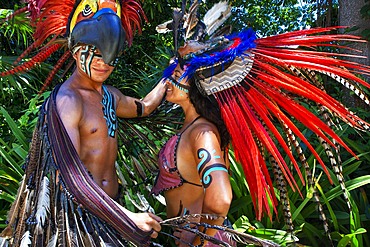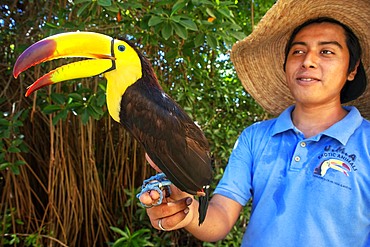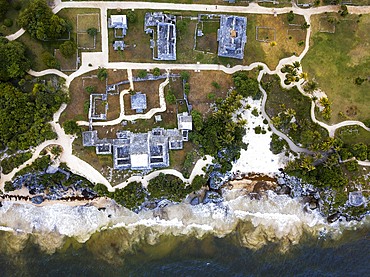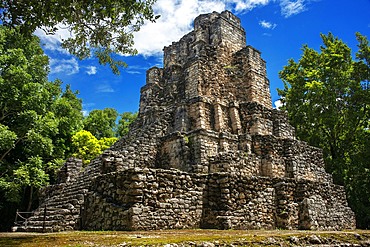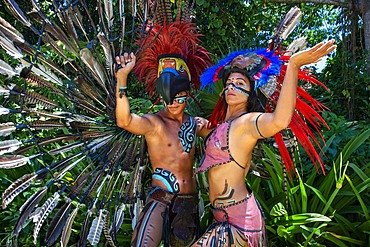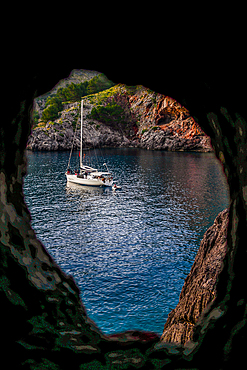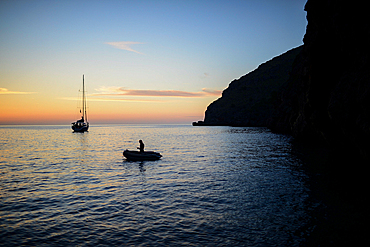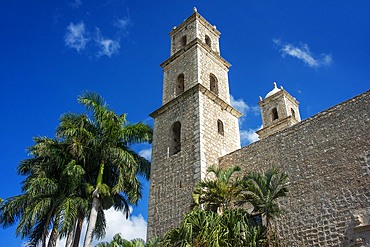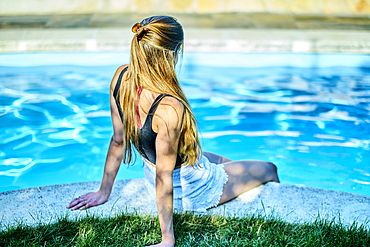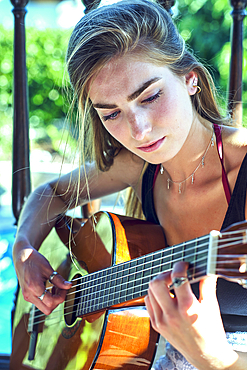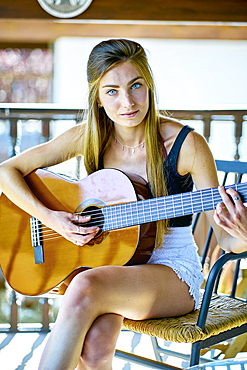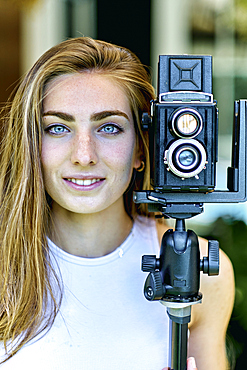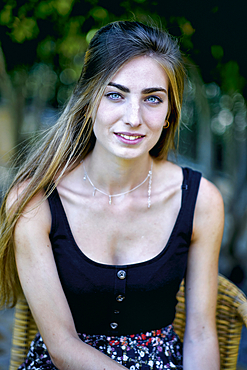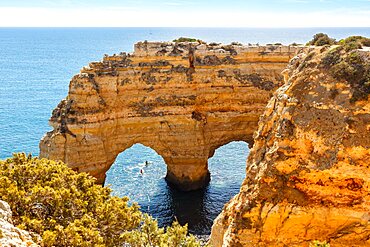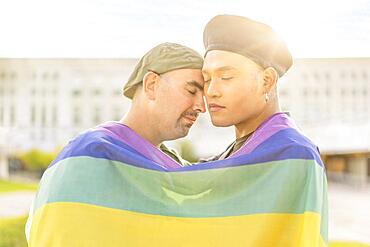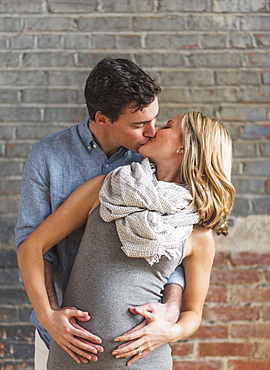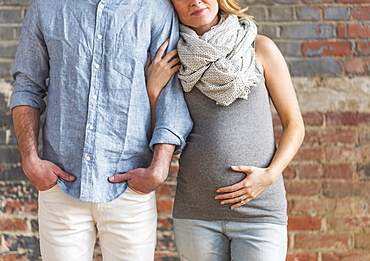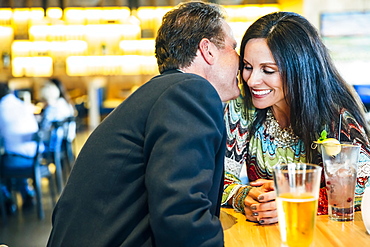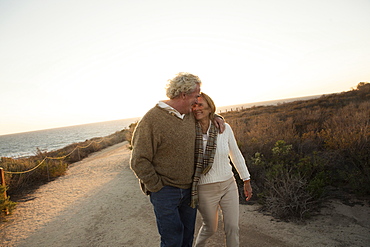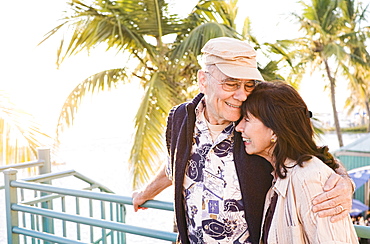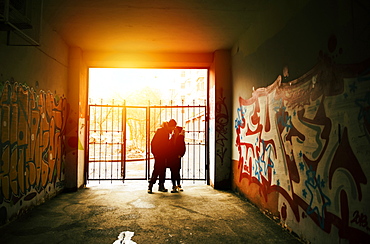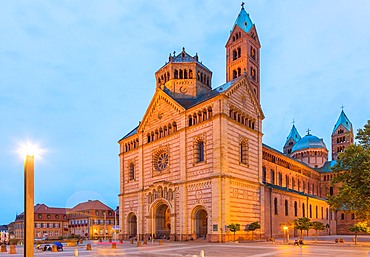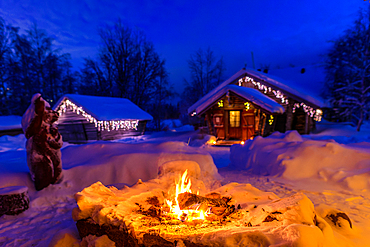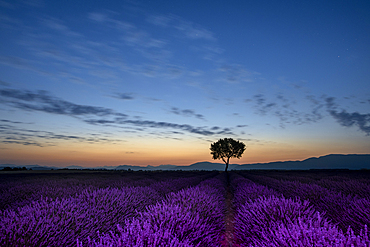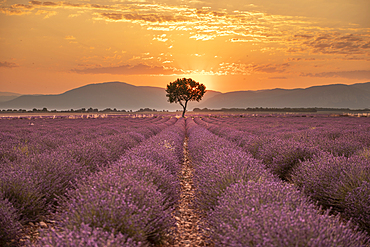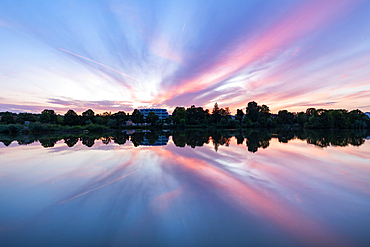Recent searches
Loading...
1350-6611 - Underwater close up view of open coral polyp during a dive, Cancun, Quintana Roo, Mexico
1350-6608 - Mexican aztec dress gods at Grand Palladium White Sand Resort and Spa in Riviera Maya, Yucatan Peninsula, Quintana Roo, Caribbean Coast, Mexico.
Aztec clothing was generally loose fitting and did not completely cover the body. When the Spanish arrived in Mexico, the people were surprised to see them in their full armour, with only their faces exposed.
Aztec clothes were generally made of cotton (which was imported) or ayate fiber, made from the Maguey Cactus (also called the Century Plant or American Aloe). Women would weave the fibers into clothing, a task girls were taught as young teenagers. Because of their vast trading network, the Aztecs were able to make use of a beautiful array of dyes, creating the brilliant
1350-6609 - Kayakking in front of the beach of Grand Palladium White Sand Resort and Spa in Riviera Maya, Yucatan Peninsula, Quintana Roo, Caribbean Coast, Mexico
1350-6606 - A Mexican staff member holds a tucan at Grand Palladium White Sand Resort and Spa in Riviera Maya, Yucatan Peninsula, Quintana Roo, Caribbean Coast, Mexico
1350-6602 - Aerial view of Grand Palladium White Sand Resort and Spa in Riviera Maya, Yucatan Peninsula, Quintana Roo, Caribbean Coast, Mexico
1350-6597 - Aerial views of El Castillo and the Ruins of the Mayan temple grounds at Tulum, Quintana Roo, Yucatan, Mexico. Tulum is the site of a pre-Columbian Mayan walled city which served as a major port for Coba, in the Mexican state of Quintana Roo. The ruins are situated on 12 meter 39 ft tall cliffs along the east coast of the Yucatán Peninsula on the Caribbean Sea in the state of Quintana Roo, Mexico. Tulum was one of the last cities built and inhabited by the Maya; it was at its height between the 13th and 15th centuries and managed to survive about 70 years after the Spanish began occupying Mexico. Old World diseases brought by the Spanish settlers appear to have resulted in very high fatalities, disrupting the society, and eventually causing the city to be abandoned.
1350-6599 - Aerial views of El Castillo and the Ruins of the Mayan temple grounds at Tulum, Quintana Roo, Yucatan, Mexico. Tulum is the site of a pre-Columbian Mayan walled city which served as a major port for Coba, in the Mexican state of Quintana Roo. The ruins are situated on 12 meter 39 ft tall cliffs along the east coast of the Yucatán Peninsula on the Caribbean Sea in the state of Quintana Roo, Mexico. Tulum was one of the last cities built and inhabited by the Maya; it was at its height between the 13th and 15th centuries and managed to survive about 70 years after the Spanish began occupying Mexico. Old World diseases brought by the Spanish settlers appear to have resulted in very high fatalities, disrupting the society, and eventually causing the city to be abandoned.
1350-6596 - Estructura 8I-13 El Castillo at Chunyaxche Muyil Maya ruins, rainforest near Tulum, Yucatan Peninsula, Quintana Roo, Mexico
1350-6595 - Mexican aztec dress gods at Grand Palladium White Sand Resort and Spa in Riviera Maya, Yucatan Peninsula, Quintana Roo, Caribbean Coast, Mexico.
Aztec clothing was generally loose fitting and did not completely cover the body. When the Spanish arrived in Mexico, the people were surprised to see them in their full armour, with only their faces exposed.
Aztec clothes were generally made of cotton (which was imported) or ayate fiber, made from the Maguey Cactus (also called the Century Plant or American Aloe). Women would weave the fibers into clothing, a task girls were taught as young teenagers. Because of their vast trading network, the Aztecs were able to make use of a beautiful array of dyes, creating the brilliant
1350-6579 - Beach chairs in Cala Formentor, Mallorca, Spain
1350-6577 - Sa Calobra Sailing boat at sunset in Torrent de Pareis, Mallorca, Spain
1350-6576 - Sailing boat at sunset in Torrent de Pareis, Mallorca, Spain
1350-6654 - The Parque Hidalgo and statue of Manuel Cepeda Peraza and The San Ildefonso Cathedral in Mérida, the capital and largest city in the Yucatan State and Yucatán Peninsula, Mexico
1350-6653 - Horse drawn carriages on a city street in front of the plaza grande square, Merida, the capital city of the Yucatan, Mexico Latin America
1350-6652 - The Bishop's Palace or Peninsula Athenaeum and The San Ildefonso Cathedral in Mérida, the capital and largest city in the Yucatan State and Yucatán Peninsula, Mexico
1350-6650 - Merida Mexico - the Merida city sign in the Plaza Grande, Merida, the capital city of the Yucatan, Mexico Latin America
1350-6649 - Portal Maya sculpture Mayan Gateway situated in Parque Fundadores by sculptor Jose Arturo Tavares in Playa del Carmen, Riviera Maya, Quintana Roo, Mexico
1350-6648 - White Mexican church and street art at 5th Avenue, Playa del Carmen, Caribe, Quintana Roo state, Mayan Riviera, Yucatan Peninsula, Mexico
1350-6646 - Colorful Mexican ceramic skulls or calaveras and Frida Kahlo souvenirs in Playa del Carmen, Riviera Maya, Quintana Roo, Mexico
1350-6645 - El Castillo, The Pyramid of Kukulkán, is the Most Popular Building in the UNESCO Mayan Ruin of Chichen Itza Archaeological Site Yucatan Peninsula, Quintana Roo, Caribbean Coast, Mexico
1350-6644 - The Church and Nunnery at Chichen Itza Archaeological Site in Yucatan Peninsula, Quintana Roo, Caribbean Coast, Mexico
1350-6643 - Stony stairs of tomb of the High Priest pyramid at Chichen Itza Archaeological Site in Yucatan Peninsula, Quintana Roo, Caribbean Coast, Mexico
1350-6642 - The Great Ball Court in the Mayan Ruins of Chichen Itza Archaeological Site Yucatan Peninsula, Quintana Roo, Caribbean Coast, Mexico
1350-6640 - Serpent head sculpture in Mayan Ruin of Chichen Itza Archaeological Site in Yucatan Peninsula, Quintana Roo, Caribbean Coast, Mexico
1350-6639 - El Castillo, The Pyramid of Kukulkán, is the Most Popular Building in the UNESCO Mayan Ruin of Chichen Itza Archaeological Site Yucatan Peninsula, Quintana Roo, Caribbean Coast, Mexico
1350-6637 - El Castillo, The Pyramid of Kukulkán, is the Most Popular Building in the UNESCO Mayan Ruin of Chichen Itza Archaeological Site Yucatan Peninsula, Quintana Roo, Caribbean Coast, Mexico. Asian tour leder dressed in a maya style.
1350-6638 - El Castillo, The Pyramid of Kukulkán, is the Most Popular Building in the UNESCO Mayan Ruin of Chichen Itza Archaeological Site Yucatan Peninsula, Quintana Roo, Caribbean Coast, Mexico
1350-6528 - Portrait from behind of a young caucasian woman in her 20´s with long hair sitting outdoor on the edge of a swimming pool. Lifestyle concept.
1350-6527 - Portrait of a young beautiful caucasian woman in her 20s lying on the grass in a garden. Lifestyle concept.
1350-6526 - Portrait of a young beautiful caucasian woman in her 20s lying on the grass and talking on her mobile phone in a garden. Lifestyle concept.
1350-6525 - Portrait of a young beautiful caucasian woman in her 20´s with long hair and blue eyes playing guitar on the porch of a country house. Lifestyle concept.
1350-6524 - Portrait of a young beautiful caucasian woman in her 20´s with long hair and blue eyes playing guitar on the porch of a country house. Lifestyle concept.
1350-6523 - Portrait of a young beautiful caucasian woman in her 20´s with long hair and blue eyes playing guitar on the porch of a country house. Lifestyle concept.
1350-6522 - Portrait of a young beautiful caucasian woman in her 20´s with long hair and blue eyes playing guitar on the porch of a country house. Lifestyle concept.
1350-6521 - Portrait of a young beautiful caucasian woman in her 20´s with long hair and blue eyes sitting outdoor on the edge of a swimming pool. Lifestyle concept.
1350-6520 - Portrait of a young beautiful caucasian woman in her 20´s with blue eyes wearing a hat and photographing with an old vintage camera on a tripod outdoor in a garden. Lifestyle concept.
1350-6519 - Portrait of a young beautiful caucasian woman in her 20´s with blue eyes photographing with an old vintage camera on a tripod outdoor. Lifestyle concept.
1350-6518 - Portrait of a young beautiful caucasian woman in her 20´s with blue eyes photographing with an old vintage camera on a tripod outdoor. Lifestyle concept.
1350-6517 - Portrait of a young beautiful caucasian woman in her 20´s with long hair and blue eyes wearing a hat outdoor in a garden. Lifestyle concept.
1350-6515 - Natural beauty portrait of young woman in her 20´s with long hair and blue eyes outdoor in a garden. Lifestyle concept.
832-398168 - Algarve beach Praia da Marinha by the sea Rock formation in the shape of a heart Ocean in Praia da Marinha, Portugal, Europe
832-397803 - Valentines day concept with True Love ticket and cupid arrows on pink background
832-397774 - Party flat lay with heart garland, napkin, champagne bottles and party hats on pink background
832-397799 - Blue pied French Bulldog dog puppy with unicorn headband with horn peeking out of box with flowers on pink background
832-397797 - French Bulldog dog with birthday part hat in front of blurry pink background with flowers and heart shaped balloons
832-397776 - Blue French Bulldog dog puppy with unicorn headband with horn sleeping in bucket
832-397806 - Pink paper hearts hanging from line with pegs and sugar sprinkles
832-397408 - Heart made of ribbon on a white background
832-397253 - Heart shaped burnt out of a texted paper
832-397255 - Chain form a heart shape on a brown background
832-397254 - Red color heart shaped object in hand on dotted paper
1179-5931 - Romantic sky at dawn over frozen trees covered with snow, Riisitunturi National Park, Lapland, Finland, Europe
1179-5898 - Romantic sunset over Saint Theodore lighthouse reflected in the sea, Argostoli, Kefalonia, Ionian Islands, Greek Islands, Greece, Europe
1116-52665 - A Couple Smiling And Holding Hands In A Restaurant
1116-52664 - Front View Of A Couple Drinking In A Restaurant
1116-52476 - Two Chairs Waiting In A Tropical Paradise
1178-43685 - Older Caucasian couple hugging outdoors
832-397227 - Retro metal keys form a heart shape on black
832-397225 - Paper man and heart icons on linen threads on canvas
832-397170 - Gay Latino male couple sitting on a bench in a park at sunset, wearing fashionable hats, holding a cell phone, smiling
832-397110 - Homosexual white male couple holding hands at a lake
832-397224 - Heart shaped object amid pencil shavings
832-397168 - Lesbian women couple in love embracing each other, wrapped in a gay flag, in a park at sunset, with reflections of the sun. Concept of diversity, pride, love, equality
832-397169 - Gay Latino male couple sitting on a bench in a park at sunset, wearing fashionable hats, holding a cell phone, smiling
832-397167 - Couple of gay men in love embracing each other, wrapped in a gay flag, in a park at sunset, with reflections of the sun. Concept of diversity, pride, love, equality
832-397223 - Red color paper hearts a yellow torn paper
832-397122 - Colorful decorative objects in the shape of a heart
832-397226 - Love concept with heart shaped papers on linen threads
1178-43025 - Caucasian man hugging and kissing expectant mother
1178-43024 - Smiling Caucasian expectant mother holding arm of man
1178-43026 - Caucasian man and expectant mother with dog and baby shoes
1178-43245 - Hispanic couple hugging in backyard sprinkler
1178-43246 - Hispanic couple hugging in backyard sprinkler
1178-43392 - Caucasian man whispering to ear of woman in restaurant
1178-43331 - Older Caucasian couple walking on dirt path
1178-43625 - Couple kissing near graffiti at urban gate
1178-43332 - Older Caucasian couple hugging outdoors
1178-43019 - Indian woman laying on bed holding bouquet of flowers
1179-5820 - Flying over the snowcapped peaks of Lepontine and Ticino Alps lit by sun rays in the romantic sky at sunset, Switzerland
1113-107468 - Sunset with a view to Rocca Maggiore Castle in Assisi, Perugia Province, Umbria, Italy
1113-107766 - View of Venice from Giudecca island Italy
1113-107691 - Speyer, Cathedral Church of St, Maria and St, Stephen, west facade, Domplatz
1113-107553 - Sauna and guesthouse Immelkartano in Levi, Finland
1113-107374 - Bouquet of flowers with roses and hydrangeas on the tip of a wooden boat
1113-107776 - Fields of lavender in full bloom under a full moon in the Valensole plateau with mature tree standing solo.
1113-107778 - Fields of lavender in bloom at sunrise in the Valensole plateau with mature tree standing solo.
1113-107355 - Cathedral Square with Alexander statue, Helsinki, Finland
1113-107398 - The lighthouse in Podersdorf am Neusiedler See during the sunset in Burgenland, Austria
1113-107685 - Cologne, city view from the Rheinboulevard on Museum Ludwig, Cologne Cathedral, Hohenzollern Bridge and the Rhine
1113-107528 - Blooming broom on the thorn bush, gorse, lighthouse, Hiddensee, Baltic Sea, Mecklenburg-Western Pomerania, Germany
1113-107631 - Spectacular sunset at the Main, Kitzingen, Lower Franconia, Franconia, Bavaria, Germany, Europe
1113-107607 - The superbly situated village of Monasanto is nestled in granite rocks high on a ridge, Beira, Portugal.
1113-107684 - Cologne, city view from the Deutzer Bridge on Groß St, Martin, Cologne Cathedral, Hohenzollern Bridge and the Rhine
1113-107728 - Rome, Trajan's markets, Trajan's forum in the evening
1113-107805 - Evening mood at Cologne Cathedral, Hohenzollern Bridge, Cologne, North Rhine-Westphalia, Germany, Europe
1113-107475 - Sunset over the Basilica di San Francesco in Assisi, Perugia Province, Umbria, Italy

